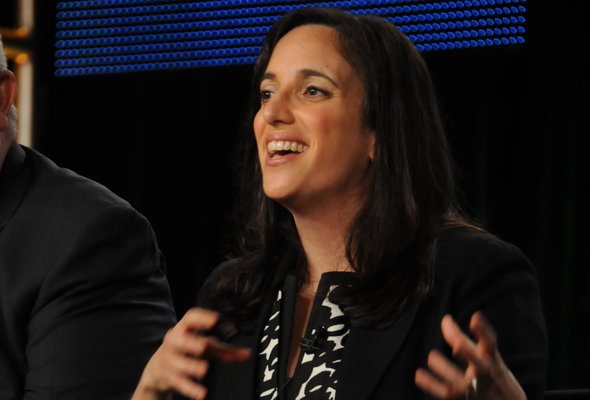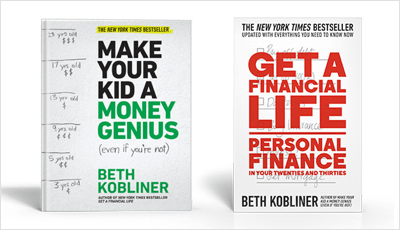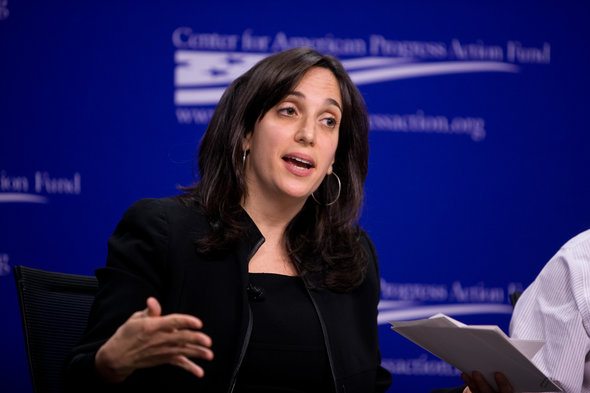Beth Kobliner has achieved success in journalism and finance over the past few decades. Her work has been featured in a number of financial publications and she’s made the rounds on TV and radio. She served on financial advisory councils for President Obama and created a teaching tool, Money as You Grow, that was later adopted by the Consumer Finance Protection Bureau. Through it all, Kobliner has worked to share what she thinks are the essential money lessons that everyone should know. Let’s take a look at some of her biggest lessons. You can also work with a financial advisor to get specialized advice for your unique financial goals.
Top Financial Advice From Beth Kobliner
The best place to start your financial journey is by getting out of debt. According to Kobliner, it’s one of the smartest financial moves you can make. In particular, she tells people to pay off their high-interest debt first. And she actually has a simple trick to help you get started. If you have credit card debt, call your credit card issuer and ask them to lower your interest rate. Believe it or not, this works a lot of the time. As Kobliner says, “If you haven’t already, contact your lenders and explain your situation. They may be willing to arrange a payment plan to suit your needs.”
Some people focus on saving before paying off their debt. Kobliner thinks this is usually the wrong approach because, in the long run, you’ll make more by getting rid of debt than by earning interest at the low rates that most savings accounts offer. The only time she thinks you should prioritize saving over paying off debt is in the case that your interest rate is lower than the rate you get from an investment. The example that she provides in her book, “Get a Financial Life: Personal Finance in Your Twenties and Thirties,” is if you have a 401(k) account with employer matching.
Contributing to a Retirement Account
And what else should you know about 401(k) accounts? Beth Kobliner recommends contributing to one if your employer offers it. Saving for retirement is important and it’s best to start while you’re young. Even contributing just a little bit now will add up over time thanks to compound interest.
She says you should especially contribute to a 401(k) if your employer offers a match. A match from your employer means that they will contribute a certain percentage of what you contribute to the account. Let’s say your employer offers a 50% match on you first 5% of contributions. That means if you contribute up to 5% of your salary, your employer will contribute an amount equal to 50% of what you put in. Kobliner suggests contributing enough to your 401(k) to receive the maximum employer match. Otherwise, you’re passing up free money.
If your employer doesn’t offer a 401(k) or equivalent account, then Kobliner says you should contribute to an IRA. An IRA provides similar benefits as a 401(k) but you don’t need to contribute through an employer. You can probably open one at the same bank you use for your other personal banking. The big difference between a 401(k) and an IRA is the contribution limit. A 401(k) has an annual limit of $18,000 while an IRA has a limit of $5,500.
The other instance she says you should use an IRA is if you have a 401(k) account but change employers and can’t move your 401(k) funds to an account with the new employer. Most employers let you transfer funds from a previous employer’s 401(k) but some won’t. In that case, you should do an IRA rollover to move your funds into an IRA. This will allow you to keep contributing.
Saving
In addition to saving for retirement, Beth Kobliner suggests saving six to nine months’ worth of expenses for a rainy day. You never know when a big expense or unanticipated challenge will come up. Having some savings will provide a cushion. The only downside Kobliner sees to saving up this emergency fund is that most savings accounts don’t offer very high-interest rates. So instead of just putting that money in a savings account, she proposes that people put these funds in a money market account. A money market account is just about as safe as a traditional savings account but usually offers better interest rates.
Kobliner knows that we all struggle with saving sometimes, nine months of expenses can be a lot. She recommends starting small and automating contributions to your rainy day fund. With automation, you build a strong savings habit and the money will go into the account even if you have other things on your mind.
Another financial move that Kobliner recommends is investing in the stock market. Other financial experts, like Jim Cramer, also talk about investing as a way to build wealth. So first of all, why should you invest? Kobliner says that, quite simply, you’ll get a better return on your money in the long run than you would if you just put money in a savings account. She explains on her blog that, “It can actually be riskier to keep [your money] in a savings account that doesn’t keep up with inflation.”
Investing should not be your first move, though. According to Kobliner, “Before buying your first share, make sure other important ducks are in a row (that includes getting rid of credit card debt, contributing to retirement plans and socking away nine months’ worth of living expenses for emergencies)”
Risk of Investing
She is also quick to remind people that investing carries risk. “Putting money in the stock market always carries risk, but how much risk depends on what you’re comfortable with and how long you plan to let your investments grow.” If you don’t have an investing strategy, you should consider talking with a financial advisor. An advisor can help you determine the best way for you to invest so that you meet your financial goals.
So let’s say you’ve decided that you want to invest. Beth Kobliner recommends investing in low-cost stock and bond funds. For stocks, she likes index funds and exchange-traded funds (ETFs). These funds are naturally diverse, which means you won’t lose all your money if one company or one sector of the economy is struggling.
You also don’t have to worry about stock picking, which is a lot of work for the average person. For bonds, Kobliner suggests a bond index fund that invests in government securities or highly rated corporations. Bonds, in general, are a relatively safe investment. They protect your money in the case of an economic downturn or a decrease in stock prices.
In her book, “Get a Financial Life: Personal Finance in Your Twenties and Thirties,” Kobliner cites an old rule when deciding how to allocate your portfolio (which is your mix of stocks, bonds and other assets like cash). The rule says to subtract your age from 100. That’s the percentage of your portfolio that should be in stocks. The rest should be in bonds and money market funds. This is just a general rule though. Only you know how much risk you’re willing to take.
A Brief Bio of Beth Kobliner

Beth Kobliner has spent decades working as a journalist and financial commentator. After graduating from Brown University in 1986, Kobliner started her career as a staff research associate for Sylvia Porter (who was a trailblazer in the field of financial journalism). Her next move was as a staff writer for Money magazine. She has also worked with and contributed to many other financial publications. You can find some of her work in the New York Times, Wall Street Journal, The Huffington Post and O, and The Oprah Magazine. Kobliner has also appeared on radio programs and TV shows like NPR and Good Morning America.
In 2010, President Obama appointed Beth Kobliner to serve on the president’s Advisory Council on Financial Capability. As part of the council, she spearheaded the Money As You Grow project. It provided online lessons, and accompanying activities, designed to teach children of different ages about money. Kobliner also worked in President Obama’s Advisory Council on Financial Capability for Young Americans.
Financial Focus and Philosophy
Beth Kobliner focuses on education. She tries to help people understand the basic steps they can take in order to reach financial stability. She particularly works with young adults and children. Her first book covers financial advice for people in their 20s and 30s. Her second book provides advice to parents for teaching their children about money. She has also worked directly with children. For example, she worked with “Sesame Street” on an initiative to teach children the basics of money.
Where You Can Find Beth Kobliner
You can learn more about her books and other projects through Beth Kobliner’s website. You can also keep up with her latest financial advice on Twitter at @BethKobliner.
Recent Projects
In 2017, Beth Kobliner released her second book, “Make Your Kid A Money Genius (Even If You’re Not).” The book is a guide to help parents talk to their children about money and finances. As she says in the book, money wasn’t something that her parents talked about when she was young. That trend is changing nowadays and she hopes her book will make it just that much easier for parents and kids to talk about money.
The Bottom Line

Beth Kobliner is passionate about financial education. She has worked her entire career to teach the money lessons that we all need to know. Her primary focus is young adults and children but her advice is useful to anyone. Kobliner’s advice is simple and practical, so you should definitely look at her work if you want to create a foundation of solid financial habits.
Tips to Help You Reach Financial Stability
- You can follow Beth’s general advice or you can get personalized advice through a financial advisor, who takes your unique financial situation into account. A financial advisor doesn’t have to be difficult to find if you don’t already have one. SmartAsset’s free tool matches you with up to three financial advisors who serve your area, and you can interview your advisor matches at no cost to decide which one is right for you. If you’re ready to find an advisor who can help you achieve your financial goals, get started now.
- Another piece of advice from Beth Kobliner is to learn your credit score and improve it. Your FICO Score is what most lenders use to decide whether or not they should offer you a line of credit. That includes credit cards, loans and mortgages. If you have a high score, you’ll get higher lines of credit and receive better loan deals. The best way to help your credit score, as Kobliner says in “Get a Financial Life,” is by paying your bills on time. Have a hard time paying on time? She advises people to set up automatic payments. This ensures that you never miss a payment, even if you’re busy and forget that your bill is due.
- One great way to maintain a healthy financial life is by not overspending on rent or a mortgage. Kobliner tells people to think hard before getting a new place. You’re going to make things very hard for yourself if you have to pay more on rent or mortgage than you can actually afford. So before you sign on any dotted lines, make sure you actually know how much house you can afford.
Photo Credit: Ralph Alswang/Center for American Progress Action Fund, ©flickr/PBS PressRoom, www.bethkobliner.com
